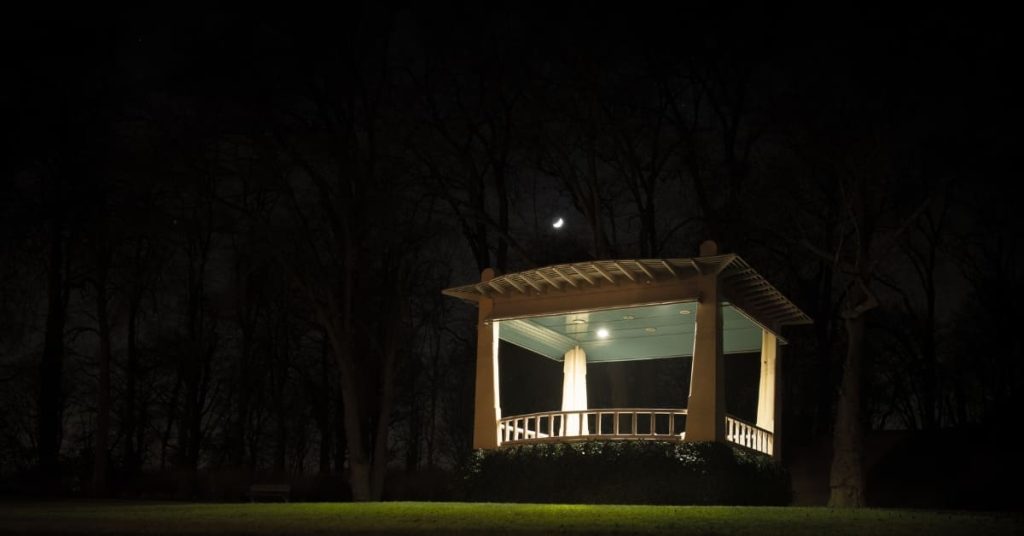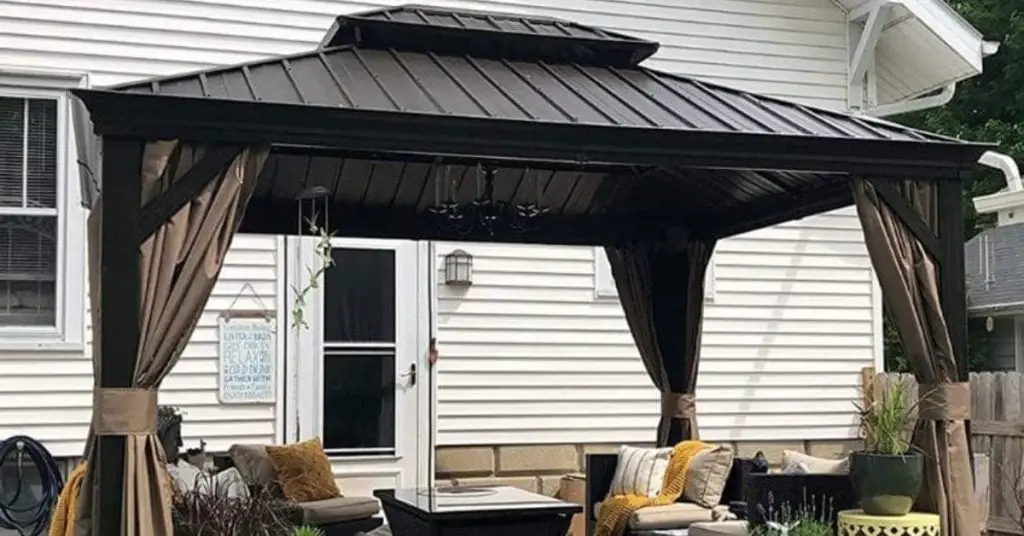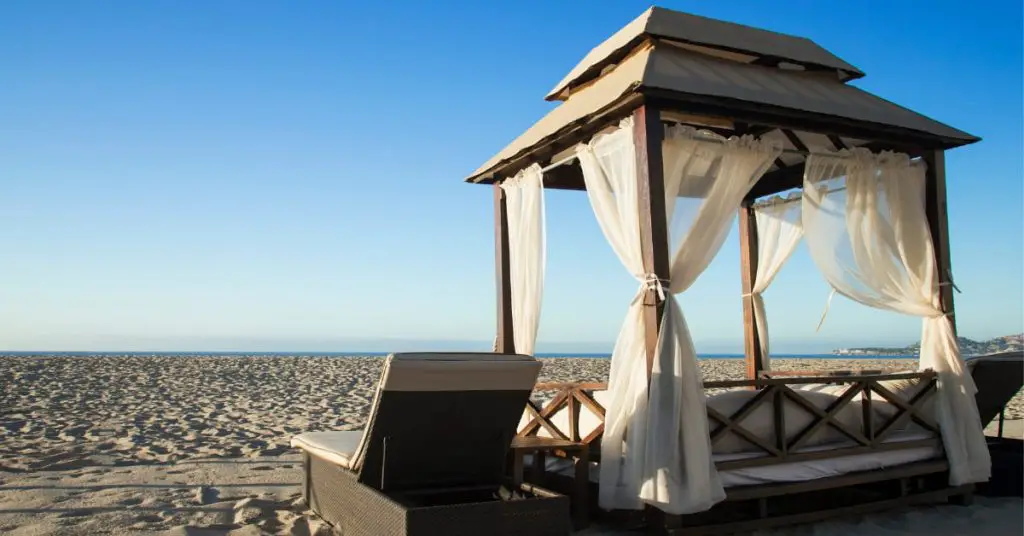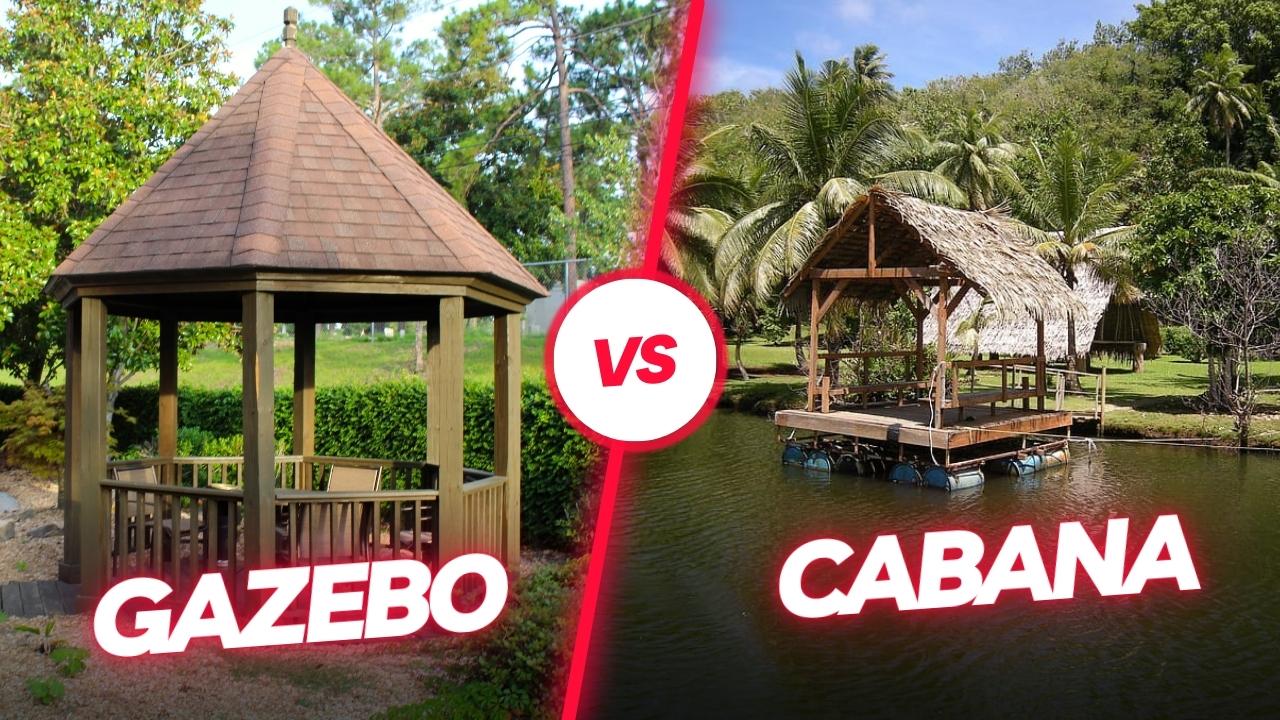Discover the ultimate outdoor oasis! Gazebo vs. cabana – which one will transform your backyard into a paradise? Find out now and create your dream escape!”
Gazebo Vs Cabana
Gazebos and cabanas are famous for creating outdoor living spaces with shade, relaxation, and aesthetic appeal. While they share some similarities, these structures have distinct differences in style, functionality, size requirements, weather protection, privacy, maintenance, cost considerations, and installation.
This article aims to critically analyze the pros and cons of gazebos and cabanas to help readers make informed decisions based on their preferences and lifestyle needs.
Regarding style and aesthetic appeal, gazebos often feature a more traditional design with open sides and a domed roof. On the other hand, cabanas typically have a modern or tropical look with closed sides and a flat or sloped roof.
Functionality-wise, gazebos are versatile spaces suitable for various activities, such as dining or entertaining guests. Cabanas focus more on providing shelter from the sun or rain while offering a cozy retreat-like atmosphere.
Size requirements differ for gazebos and cabanas depending on their intended use. Gazebos generally require larger areas due to their open design, while cabanas can be placed in smaller spaces since they have enclosed sides.
Regarding weather protection, gazebos offer limited shelter from wind and rain, whereas cabanas provide better coverage due to their closed structure.
Privacy is another factor when choosing between a gazebo or a cabana. Gazebos typically lack complete privacy as they have open sides that may expose occupants to outside views. In contrast, cabanas provide more seclusion thanks to their enclosed walls, creating a private oasis-like space.
Maintenance requirements vary for both structures as well. Gazebos may require regular cleaning of debris, such as leaves or twigs that accumulate on its open structure. Maintenance tasks like staining or sealing wooden gazebos need periodic attention to ensure longevity.
Cabanas with closed sides may require less cleaning but might need an occasional inspection for any damage to their walls or roof.
Cost and budget considerations play a significant role in the decision-making process. Gazebos tend to be more affordable options compared to cabanas, thanks to their more straightforward design and construction.
However, the cost may vary based on materials, size, and additional features such as screens or built-in seating. Cabanas are generally more expensive due to their enclosed structure, which requires precise construction and more substantial materials.
Installation and assembly can also influence the choice between a gazebo or a cabana. Gazebos often come in prefabricated kits.
Style and Aesthetic Appeal
The style and aesthetic appeal of the gazebo and cabana structures are essential to consider, as they can evoke a sense of elegance and create an inviting atmosphere.
Gazebo structures often feature a more traditional design with octagonal or hexagonal shapes and intricate details such as columns and latticework. This classic style appeals to those who desire a timeless look for their outdoor space.
On the other hand, cabanas offer a more modern and contemporary aesthetic. These structures typically have clean lines, minimalistic designs and often incorporate glass, metal, or concrete.
The sleek and streamlined appearance of cabanas can create a sophisticated atmosphere favoured by individuals who appreciate a more minimalist approach.
Both gazebo and cabana styles have their unique charm and appeal. It ultimately comes down to personal preference and the desired ambience one wishes to create in their outdoor space.
While some may be drawn to the traditional elegance of gazebos, others may prefer the sleekness of cabanas. Regardless of choice, both options provide opportunities to transform an outdoor area into an inviting space that reflects one’s taste and creates a sense of belonging within the environment.
Functionality and Purpose
Functionality and purpose vary significantly between the two structures.
Gazebos and cabanas serve different functions and cater to distinct purposes, making them suitable for diverse settings.
Gazebos are primarily designed as open-air structures, often with a roof but no walls. They offer a shaded space for relaxation or entertainment in outdoor settings such as gardens or parks.
Their functionality lies in providing shelter from direct sunlight while allowing for ventilation and an unobstructed view of the surroundings. Gazebos can be used for various activities, including dining, socializing, or enjoying nature.
On the other hand, cabanas are more enclosed structures that typically feature walls and a roof. They are commonly found near pools or beaches and serve as private retreats offering shade, comfort, and privacy.
Cabanas provide a secluded space where individuals can relax, change clothes, or store personal belongings while enjoying leisure activities like swimming or sunbathing.
Understanding the differences in functionality and purpose between gazebos and cabanas allows individuals to make informed choices based on their specific needs.
Whether seeking an open space for communal gatherings or a private oasis by the water’s edge, both options offer unique advantages that enhance one’s outdoor experience.
Size and Space Requirements

This discussion will focus on the size and space requirements of gazebos and cabanas, highlighting the key differences between the two structures.
Gazebos are known for their larger structure and seating capacity, making them ideal for hosting large gatherings or events.
On the other hand, cabanas have a smaller footprint and create a more intimate and cosy atmosphere, suitable for small groups or individuals seeking privacy.
These aspects can help individuals choose between a gazebo or a cabana for their outdoor space.
Gazebo’s Larger Structure and Seating Capacity
With its expansive structure and ample seating, the pavilion offers a grand and comfortable space for social gatherings. The larger size of a gazebo allows for more people to be accommodated, making it ideal for hosting significant events such as weddings or parties.
Gazebo’s seating capacity is often more significant than a cabana’s, providing enough room for guests to sit and relax comfortably. Additionally, the spaciousness of a gazebo allows for various seating arrangements, offering flexibility in creating different atmospheres within the space.
This versatility is highly valued by individuals seeking to create an inviting environment where people can gather and connect.
Overall, the larger structure and increased seating capacity of a gazebo make it an excellent choice for those looking to host gatherings with a significant number of attendees while still providing comfort and elegance.
Cabana’s Smaller Footprint and Cozy Atmosphere
A cabana’s compact size and intimate ambiance create an enchanting setting that evokes a sense of coziness and charm, perfect for creating memorable moments with loved ones.
Unlike gazebos, which tend to have larger structures and seating capacities, cabanas offer a smaller footprint for a more intimate gathering.
The cosy atmosphere created by the cabana’s compact design fosters a feeling of closeness among those present, encouraging deeper connections and meaningful conversations.
This smaller size also promotes a sense of exclusivity and privacy, making it ideal for individuals or groups seeking a more secluded experience.
Additionally, the reduced space in cabanas allows for greater attention to detail in terms of decor and furnishings, further enhancing the overall aesthetic appeal.
In this way, cabanas provide an inviting haven where individuals can feel a sense of belonging while enjoying precious moments with their loved ones.
Weather Protection
One notable aspect to consider when comparing gazebo and cabana structures is their ability to provide shelter from various weather conditions. Both gazebos and cabanas are designed to offer protection from the elements, allowing individuals to enjoy outdoor spaces regardless of the weather. However, there are some critical differences in how they achieve this.
Gazebos typically have a more solid structure than cabanas, often featuring a roof and walls made of durable materials such as wood or metal. This provides excellent protection against rain, wind, and even snow. Additionally, gazebos can be enclosed with screens or curtains for added privacy and protection from insects.
On the other hand, cabanas usually have a more open design with only a roof overhead. While this may not provide as much shelter during heavy rainfall or strong winds, it allows for better ventilation and a more natural connection with the surrounding environment. Cabanas are ideal for sunny days when individuals want shade but still want an outdoor experience.
Choosing a gazebo or a cabana depends on your specific needs and preferences. A gazebo might be better if you prioritize complete weather protection and versatility in different seasons.
However, a cabana could be the perfect choice if you value an open-air atmosphere and prefer lighter structures that blend seamlessly with nature.
Privacy and Seclusion
Privacy and seclusion are essential factors to consider when comparing the structures of gazebos and cabanas. Both structures offer a certain degree of privacy, but there are differences in the level of seclusion they provide.
- Gazebos typically have open sides or lattice walls, allowing some visibility from outside. This can be ideal for those who want to enjoy their surroundings while maintaining privacy. However, it may not offer complete seclusion from prying eyes.
- Conversely, cabanas often have solid walls or curtains that can be drawn for added privacy. This makes them more suitable for individuals seeking a higher level of seclusion. It creates a private retreat where one can relax away from the gaze of others.
When considering privacy and seclusion, thinking about personal preferences and specific needs is essential. Some individuals may prioritize enjoying their surroundings while connecting with others nearby. In contrast, others may value complete isolation and solitude.
Choosing between a gazebo or a cabana depends on an individual’s desired level of privacy and seclusion. By carefully considering these factors, one can select the structure that best suits their needs and provides them with a space where they feel comfortable and secure.
Maintenance and Durability
This discussion will focus on the maintenance and durability of gazebos and cabanas.
Gazebos are known for their sturdy and long-lasting construction, making them a reliable choice for outdoor structures.
On the other hand, cabanas often feature lightweight materials that are easy to maintain, providing convenience for those looking for low-maintenance options.
Examining these key points will shed light on the advantages and disadvantages of each option in terms of their durability and maintenance requirements.
Gazebo’s Sturdy and Long-lasting Construction

Gazebo’s robust and durable structure ensures its longevity. Constructed with high-quality materials such as solid metal frames or sturdy wooden beams, gazebos are designed to withstand various weather conditions and provide a long-lasting outdoor shelter.
The use of thick, weather-resistant roofing materials further enhances their durability. Additionally, incorporating reinforced joints and connections adds strength to the overall structure, preventing any potential weak points that could compromise its stability.
This attention to detail in construction ensures the gazebo can withstand years of use and minimizes the need for frequent repairs or replacements. By investing in a well-built gazebo, individuals can enjoy a reliable outdoor space that will remain intact and functional for an extended period, providing them with a sense of security and belonging within their surroundings.
Cabana’s Lightweight and Easy-to-Maintain Materials
Cabanas are often constructed using lightweight materials and designed with easy maintenance in mind. These features make cabanas popular for those seeking a portable, hassle-free outdoor living space.
The lightweight materials used in cabana construction, such as aluminium frames and synthetic fabrics, make them easier to transport and contribute to their overall durability.
Additionally, these materials are resistant to rust, mold, and fading caused by prolonged exposure to sunlight or water. This ensures that cabanas maintain their aesthetic appeal over time without requiring extensive upkeep.
Moreover, synthetic fabrics allow easy cleaning and stain removal, enhancing convenience. The lightweight construction and easy maintenance make cabanas attractive for individuals seeking a practical yet stylish outdoor retreat.
Cost and Budget Considerations
The cost and budget considerations of choosing between a gazebo and a cabana are important factors.
One key point is that gazebos require a higher initial investment than cabanas. This is due to gazebos’ more elaborate design and construction, often featuring intricate details and larger structures.
On the other hand, cabanas generally fall within a more affordable price range, making them a more budget-friendly option for those looking for outdoor shelter or relaxation spaces.
Gazebo’s Higher Initial Investment
One cannot ignore the significant financial commitment required when considering the installation of a pavilion. While cabanas may offer a more affordable option, gazebos generally have a higher initial investment. This is due to several factors, including materials, size, and design complexity.
Gazebos are often constructed from high-quality materials such as hardwood or vinyl, which can be costly compared to the materials used in cabanas. Additionally, gazebos tend to be larger and may feature intricate designs that require skilled construction labor. These factors contribute to the higher price tag associated with gazebos.
However, it is essential to consider that while gazebos may require a more excellent upfront investment, they can also add significant value to a property and provide long-term enjoyment for homeowners.
Cabana’s More Affordable Price Range
The affordable price range of cabanas offers a more budget-friendly option for outdoor relaxation and entertainment. Cabanas provide a cost-effective alternative to gazebos, making them accessible to more individuals seeking outdoor comfort and leisure. With their lower initial investment, cabanas allow homeowners to create a cosy retreat without breaking the bank.
The affordability of cabanas does not compromise on quality or style; various options are available that cater to different aesthetic preferences and functional needs.
Additionally, the competitive pricing of cabanas enables individuals who desire a sense of belonging in outdoor spaces. However, it may still have limited financial resources to enjoy the benefits of having an inviting and comfortable area for socializing or personal relaxation.
Installation and Assembly
The installation and assembly process of a gazebo is often complex and time-consuming. It requires careful planning, precise measurements, and multiple steps to ensure stability and durability.
On the other hand, cabanas offer a quick and easy installation process that can be completed in a fraction of the time compared to gazebos. This makes cabanas a more convenient option for those looking for a hassle-free outdoor structure.
Gazebo’s Complex and Time-consuming Setup

Gazebo’s setup process involves many intricate steps, demanding considerable time and effort. The complexity of the assembly can be overwhelming for individuals with limited experience in construction or technical skills.
From laying the foundation to assembling the framework, every step requires careful attention to detail and precise execution.
Additionally, the instructions may not always be clear or comprehensive, complicating the setup process. This complexity can result in frustration and delays, potentially deterring individuals from completing the installation.
While Gazebo offers a versatile and aesthetically pleasing outdoor structure, potential buyers should know the complex setup involved. Alternative options such as Cabana, which boasts a simpler and more user-friendly assembly process, might be worth exploring for those seeking a hassle-free outdoor living space solution.
Cabana’s Quick and Easy Installation
Cabana’s installation process is efficient and straightforward, offering a convenient solution for individuals seeking a hassle-free outdoor living space.
Unlike the complex and time-consuming setup required for gazebos, Cabana provides a quick and easy installation experience. This is particularly advantageous for those who value their time and seek immediate results.
The streamlined design of Cabana eliminates the need for specialized tools or extensive construction knowledge, making it accessible to a wide range of users. Additionally, Cabana’s user-friendly instructions ensure that even inexperienced individuals can successfully assemble their outdoor retreat without any difficulty.
By prioritizing ease of installation, Cabana caters to the needs of busy individuals who desire an inviting outdoor space without investing significant time or effort into its creation.
Personal Preference and Lifestyle
One possible sentence that meets the given criteria is: ‘Personal preference and lifestyle play a crucial role in determining whether one would prefer a gazebo or a cabana.’
When deciding between a gazebo and a cabana, individuals should consider their preferences and lifestyle to make an informed choice. Here are four factors to consider:
- Purpose: Determine how you plan to use the outdoor space. If you prioritize relaxation and privacy, a cabana may be more suitable as it provides enclosed walls for seclusion. On the other hand, if you enjoy hosting gatherings or want an open-air retreat, a gazebo with its open design may be preferable.
- Aesthetics: Consider the overall style and appearance that appeals to you. Cabanas often evoke a tropical or resort-like atmosphere with their luxurious fabrics and canopies. In contrast, gazebos tend to have a more traditional or classic design with solid roofs and intricate details.
- Maintenance: Evaluate the level of maintenance required for each option. Cabanas typically require more upkeep due to their fabric materials that may need cleaning or replacement over time. Conversely, Gazebos are usually made from durable materials such as wood or metal that require less maintenance.
- Climate considerations: Consider your local weather conditions when choosing between a gazebo and a cabana. Cabanas provide better protection against wind, rain, and excessive sunlight due to their enclosed structure compared to gazebos which offer partial shade but limited shelter.
By carefully considering these factors based on personal preference and lifestyle needs, individuals can select a gazebo or a cabana that aligns with their desired outdoor experience.
Gazebo Vs Cabana
Gazebos and cabanas provide shade and shelter from the sun, offering a tranquil space to relax and lounge during sunny days. While both structures serve this purpose, gazebos are open on all sides, whereas cabanas feature walls made from fabric, screens, or other lightweight materials.
Related Article: WHAT’S THE DIFFERENCE BETWEEN A GAZEBO AND A CABANA?
Frequently Asked Questions
Q.1 Can a gazebo or cabana be a permanent living space or guest house?
A gazebo or cabana is not designed to be used as a permanent living space or guest house. They are typically open-air structures that lack the necessary features for a comfortable, long-term occupation.
Q.2 Are there any safety precautions to consider when using a gazebo or cabana?
Safety precautions to consider when using a gazebo or cabana include ensuring proper structural integrity, securing against solid winds, avoiding placement near flammable materials, and employing appropriate lighting and electrical safety measures.
Q.3 Can a gazebo or cabana be customized or modified to fit specific design preferences?
Gazebos and cabanas can be customized or modified to fit specific design preferences. This allows individuals to create a unique outdoor space that aligns with their aesthetic tastes and enhances the overall ambience of their surroundings.
Q.4 Are there any additional features or accessories that can be added to enhance the functionality of a gazebo or cabana?
Additional features and accessories can enhance the functionality of both gazebos and cabanas. Examples include lighting fixtures, ceiling fans, mosquito netting, heaters, furniture, and sound systems. These additions provide users comfort, convenience, and ambiance in various outdoor settings.
Q.5 Are there any restrictions or regulations regarding installing a gazebo or cabana in certain areas or neighborhoods?
Restrictions and regulations regarding the installation of gazebos or cabanas vary by location and neighbourhood. Factors such as zoning laws, property size, setback requirements, and homeowner association rules can impact the permissibility of these structures in certain areas.
Conclusion
In conclusion, when comparing gazebo and cabana options, it is essential to consider several factors.
Both structures’ style and aesthetic appeal should be considered, as well as their functionality and purpose.
Size and space requirements must also be considered, along with the level of weather protection each structure offers.
Privacy and seclusion are additional factors to consider, as well as maintenance and durability.
Cost and budget considerations play a role in decision-making, as does the ease of installation and assembly.
Personal preference and lifestyle will ultimately guide the choice between a gazebo or cabana structure.

